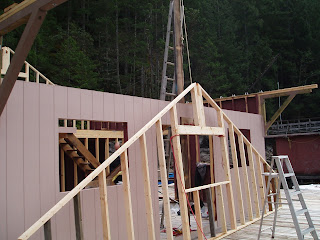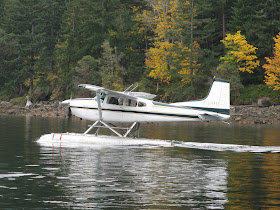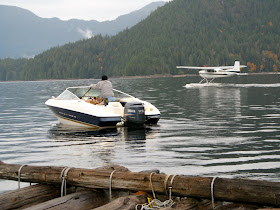 Our good friend John has been working steadily on his new cabin this month. So far, you've seen a little bit about the float assembly and raising the cabin walls. Much of the construction has been done by John himself, but when it came to the high work he got helping hands from his dad Ed, his brother Rick and my husband Wayne. The extent of my assistance has been moral support, ladder holding and photo journaling.
Our good friend John has been working steadily on his new cabin this month. So far, you've seen a little bit about the float assembly and raising the cabin walls. Much of the construction has been done by John himself, but when it came to the high work he got helping hands from his dad Ed, his brother Rick and my husband Wayne. The extent of my assistance has been moral support, ladder holding and photo journaling. I missed the day that the front and back wall extensions went into place, but looking at the pictures Ed took I can imagine the exciting event. A tall pole was used to hold a block and tackle assembly. Then the framed peak was lifted and nailed in place. Once the back was done, the front came next.
I missed the day that the front and back wall extensions went into place, but looking at the pictures Ed took I can imagine the exciting event. A tall pole was used to hold a block and tackle assembly. Then the framed peak was lifted and nailed in place. Once the back was done, the front came next.

Each peak was notched to accept the heavy ridge pole. John went up the ladder while Wayne and Ed helped raise the end of the pole up to him. John used the front wall and window cross beams to inch the pole up a bit at a time up and finally into the slot in the front peak. It was a manhandling feat! I was on ladder holding duty for this part, so there are no pictures. But here is a short video clip of the other end going into the center support.
 The back half of the beam was glued and nailed in place, but that was a lot easier because the guys could stand on the loft. Ed sure seems happy to have this part of the project done doesn't he? He's a great dad and a good friend to us as well. -- Margy
The back half of the beam was glued and nailed in place, but that was a lot easier because the guys could stand on the loft. Ed sure seems happy to have this part of the project done doesn't he? He's a great dad and a good friend to us as well. -- Margy






















